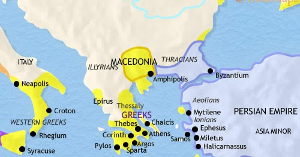Syracuse: Shining Light of Ancient Sicily
Syracuse enjoyed many highs and suffered many lows during its prominence as a Greek city-state, alternating between democracy and tyranny before finally being absorbed first by the Romans, in the 3rd Century B.C., and then by an Arab force, in the 9th Century. With its position on Sicily's southeast coast, Syracuse had a say in the progress of several Mediterranean civilizations and wars. Many sources say that settlers from Corinth established Syracuse in the mid-8th Century B.C. and ruled it for a time as an oligarchy. 
The manner of government differed in the early days of Syracuse, with the most prominent leader being the tyrants Hippocrates and Gelon; it was the military buildup of the latter that resulted in a defeat of the mighty Carthaginian forces at the Battle of Himera, in 480 B.C. The resulting victory meant for Syracuse a prolonged period of peace and prosperity. Among the prominent buildings were a large Temple of Apollo and a large Temple of Athena. Another strong leader, Hieron (a younger brother of Gelon), continued the city-state's path forward, including its reputation as a center of culture. Noted poets Aeschylus, Pindar, and Simonides lived in Syracuse for a time. Among Syracuse's foes during this period were the Etruscans, whom a combined Cumae-Syracuse force defeated in the pivotal Battle of Cumae, in 474 B.C. When Hieron died, in 467 B.C., the city-state returned to democracy, in a system of government modeled after that of Athens. As was the case often in ancient times, Greek city-states went to war with one another; such was the case with Athens and Syracuse, most notably in 415 B.C. In that year, the famous Athenian general Alcibiades sent a huge force, numbering more than 5,000 men, against Syracuse, in the latest in a series of struggles between the powers dating back more than a dozen years. This latest attack, known in some sources as the Sicilian Expedition, also featured armies belonging to other city-states, including Corinth and Sparta. The invasion went particularly well for Athens initially, but Syracuse eventually prevailed in the third and final naval battle, in 413 B.C. In the aftermath, Athenian generals Demosthenes and Nicias were captured and killed. This came during the second phase of the Peloponnesian War and was, in fact, the largest military operation of the sustained conflict. Syracuse allied with Sparta during this time. Syracuse had, since 430 B.C., been ruled by Dionysius I, a tyrant. Dionysius emerged relatively unscathed from the Peloponnesian War and also fought against Carthage in that civilization's attempt to dominate the island of Sicily. Dionysius was known as an innovative military strategist, employing variants on traditional methods of warfare, and the Syracuse naval forces at this time were known as the strongest in the Mediterranean region. He was, however, defeated by a Carthaginian force under Hanno the Great, in 367 B.C. and then died under mysterious circumstances. Dionysius II took the throne when his father died. A serious of briefly successful rulers followed, including an oligarchy for a time and even a stint as a tyrant by Pyrrhus of Epirus. Hieron II returned stability and prosperity to Syracuse, in 238; among the more famous residents at this time were the famed philosopher Plato and Archimedes (utterer of the famous "Eureka!"), who put his scientific knowledge to use in the manufacture of inventive weapons. Hieron's successor, Hieronymus, threw in his lot with Carthage during the Second Punic War, and Syracuse paid the price when Rome finally prevailed over the famed general Hannibal. Roman forces under Marcus Claudius Marcellus laid siege to the city-state in 213 and then sacked it two years later. Syracuse was named a Roman provincial capital in 21 B.C. and was a significant settlement for a few hundred years after that. Among the benefits of being a Roman colony were an infusion of money and workers to build an aqueduct, a triumphal arch, and a new amphitheater. Syracuse began a slow decline, punctuated with occupations by Franks, Vandals, and Byzantines – the last of those conquered all of Sicily in A.D. 535 and ruled it until defeat by Arab forces in 878 ended Western hegemony. As with other Greek city-states, Syracuse was the focal point for many myths.
|
|
Social Studies for Kids
copyright 2002–2025
David White




